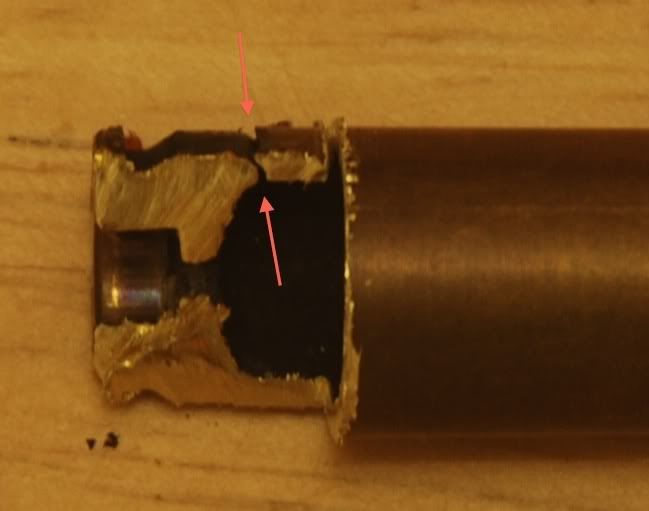No, it doesn't. Certainly not in only 20 years, unless it was sitting in a really substandard set of conditions.
Certain problems can cause brass to become brittle and weak, particularly corrosion that breaks down the bonds of the alloy, leaving patches of copper or zinc that lack the strength of the virgin alloy.
That is what mercury primers did; the mercury would cause weak spots by breaking down the alloy. I believe, personally, that it was a vastly overrated problem, as a miligram of metallic mercury vapors vs a a heavy sheet of brass should be negligible.
I really am at a loss on this one. I'm not ashamed to say it. There just doesn't seem to be an obvious smoking gun, and all of the evidence I see just doesn't seem to point to any single thing. No matter what happened, brass is elastic, and should not have torn like that, and your brass, from what I can see, is still clean and undamaged alloy.
You would expect to see this in badly corroded ammunition, ammo that had deteriorating powder, steel shells, cheap brass, extremely old brass that had weakened and damaged alloy, and other various circumstances that would have weakened the brass of the walls badly.
A case rupture like that is one of the least things you would expect from an over pressure. that is the strongest part of a shell except the web, and it is backed up by solid chamber steel, 100%. An over pressure situation, in my experiences, almost always causes failure at the case head where it is unsupported.
I am still thinking that there are only a couple possible solutions, and since you say that sizing was not a problem, I'm going to have to go with a flaw in the sheet metal, or the drawing, that left some sort of weak spot in the shell.
Brass, as you all probably know, starts out as a heavy disk that is forced into dies with a mandrell, and the disc is forced into a cup shape and then stretched thinner and thinner. it's annealed a couple times as it work hardens. IIRC, there are over a \dozen stretching and pressure forming steps for a shell, then shaping,punching, and forming. That is a lot of working. In the initial draws, I am sure that at some point, a fold or weak spot could have occurred, and as more and more reshaping took place, that weak spot could be hidden. Then, given high pressure and stretching, it could have failed, as the cartridge forward of the case head expanded faster and farther than the case head did.
I can say one thing, I suspect that this failure happened real early in the igniftion. That is the only reason I can think of for all the sooty black burns. If the entire charge had ignited and reached peak pressure, ther should not ahve been so much loose carbon in the gasses. The bullet may not have even completely left the casing yet.


